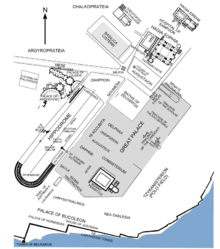Philoxenos cistern
The Philoxenos cistern ( Greek Κινστέρνα Φιλοξένου ) or Binbirdirek cistern ( Turkish Binbirdirek Sarnıcı , German 1001 column cistern ) is a closed cistern from the time of the Byzantine Constantinople . After the Basilica Cistern, it is the second largest covered cistern in the city.
location
The cistern was in the center of the old city of Constantinople between the Forum of Constantine and the hippodrome . Today the cistern is located in the Binbirdirek district of Istanbul's Fatih district . The entrance is at İmran Öktem Sokak 4.
Surname
The exact origin of the name is unclear. It could be reminiscent of the architect Philoxenos , who could have built the cistern in the 4th century. However, recent studies show that the cistern was probably not built until the 5th or 6th century. A possible namesake could have been the consul Philoxenus or a Magister officiorum of the same name . But it could also be an incorrect attribution, since there are other cisterns around the cistern.
The name Binbirdirek means 1001 (pillars), but the cistern only has 224 pillars. The reason for the name is that the Turkish number binbir is often used to describe something numerous.
history
The cistern was built in the 5th / 6th Erected in the 18th century next to the Antiochus Palace . While the undecorated capitals point to the 5th century, the stamps of the bricks seem to point to the 6th century.
After the Ottoman conquest of Constantinople in 1453 , the cistern was no longer used as a water reservoir. Instead, a silk workshop was housed here in the late 15th century until the palace of Fazli Pascha was built in the 17th century. In the 19th century, a silk mill was again housed here. The structure was used as a warehouse in the 20th century before being turned into a museum and restored in 2003.
description
The underground reservoir is 64 meters long and 56.4 meters wide. It covers an area of approx. 3,600 m² and could absorb 40,000 m³ of water. The cistern is a vaulted hypostyle . The 224 columns are 12.4 meters high, 0.6 to 0.65 meters thick and made of marble from nearby Marmara Island . They stand in 16 rows with 14 columns each. Each column consists of two columns standing on top of each other, which are connected by a marble ring. The joints are filled with lead. The bottom of the cistern was later reinforced so that only the upper column, the marble ring and a few centimeters of the lower column are visible. The original height can be seen in a basin with four columns in the middle of the cistern. Most of the columns and the capitals bear a Greek stonemason's mark. The walls and vaulted ceilings were made of bricks.
literature
- Philipp Forchheimer , Josef Strzygowski : The Byzantine water tanks of Constantinople (= Byzantine monuments. Contributions to the history of Byzantine architecture and the topography of Constantinople, Volume 2). Printed by and published by the Mechitharist Congregation, Vienna 1893, p. 57 ( digitized version ).
- Wolfgang Müller-Wiener : Pictorial dictionary on the topography of Istanbul. Byzantium, Constantinupolis, Istanbul until the beginning of the 17th century . Wasmuth, Tübingen 1977, ISBN 978-3-8030-1022-3 , p. 280 f.
Web links
Individual evidence
- ↑ Jonathan Bardill: The Palace of Lausus and Nearby Monuments in Constantinople: A Topographical Study . In: American Journal of Archeology . Volume 101, 1997, pp. 67-95, here p. 71.
- ^ A b Jonathan Bardill: The Palace of Lausus and Nearby Monuments in Constantinople: A Topographical Study . In: American Journal of Archeology . Volume 101, 1997, pp. 67-95, here p. 73.
- ↑ binbir , Türk Dil Kurumu, Atatürk Kültür, Dil ve Tarih Yüksek Kurumu, accessed on May 10, 2019
- ↑ a b c d Wolfgang Müller-Wiener: Image dictionary on the topography of Istanbul. Byzantium, Constantinupolis, Istanbul until the beginning of the 17th century . Wasmuth, Tübingen 1977, ISBN 978-3-8030-1022-3 , p. 280 f.
- ^ Cistern of Philoxenos , The Byzantine Legacy, accessed May 10, 2019
- ↑ a b Philipp Forchheimer, Josef Strzygowski: The Byzantine water tanks of Constantinople (= Byzantine monuments. Contributions to the history of Byzantine architecture and the topography of Constantinople, Volume 2), printed and published by the Mechitharisten-Congregation, Vienna 1893, p. 57.
- ↑ Alexander Kazhdan: Cisterns . In: The Oxford Dictionary of Byzantium . Volume 1, Oxford University Press, Oxford 1991, pp. 518 f.
Coordinates: 41 ° 0 ′ 27 ″ N , 28 ° 58 ′ 28 ″ E




